
Introduction
The motherboard we are looking at today is the BIOSTAR Racing Z690 GTA (Z690GTA Ver. 5.0) Socket 1700 motherboard. It is a DDR4, LGA 1700 motherboard based on Intel’s Z690 chipset. Given the transitional nature of the chipset, you can get some motherboards with either DDR4 or DDR5 support. However, none of the boards we’ve seen that have variants supporting either memory technology do so at the same time, meaning you have to buy the version you want and you are stuck with it.
Additionally, all of the DDR4 motherboards can best be classified as mid-range offerings at best. All of the higher-end motherboards are DDR5 based and the majority of those are considerably more expensive. Even DDR4 motherboards are expensive with the BIOSTAR Z690 GTA Racing coming in at $319.99 at the time of this writing.
BIOSTAR Racing Z690 GTA



The packaging for the Biostar Racing Z690 GTA is relatively basic. It has this sort of TRON aesthetic to it which extends to the motherboard itself. Inside the box, there isn’t a whole lot bundled with the Z690. You get a user manual some SATA cables, M.2 screws, and a driver CD-ROM you’ll just throwback in the box and ignore. The motherboard itself sits in a foam protector and is zip-tied in place. This is similar to what ASRock does with its boards, but is generally not done by most manufacturers.
BIOSTAR Racing Z690 GTA Features
The motherboard features support for all current Core i9/i7/i5 and i3 series processors that use the LGA 1700 socket type. The motherboard also features PCIe 5.0 support, DDR4 memory support, dual-channel memory mode operation, 8x SATA ports, 3x M.2 sockets, 2.5GbE networking, WiFi antenna connections, Optane technology, USB 3.2 Gen 2, HDMI 2.0, etc.
The BIOSTAR Racing Z690 GTA is built on a 6-layer “Moisture Proof” PCB. BIOSTAR isn’t the first to use a PCB with moisture-resistant properties. This feature isn’t something I would have thought all that important, but evidently, it can be a problem in more humid areas across the world.
The BIOSTAR Racing Z690 GTA features all-metal heat sinks like any other motherboard. However, BIOSTAR does mention its air diffuser which is used to direct air from the active heat sink fans to the heat sinks cooling the VRMs. Biostar’s Armor gear feature protects the I/O interfaces while continuing the Tron-style racing aesthetic that Biostar is going for on this board.
Unfortunately, BIOSTAR hasn’t said much about the configuration of the Z690 GTA’s VRMs and voltage hardware. I had to track down a press release to find out how many phases we were talking about here, and even that wasn’t helpful. BIOSTAR claims the motherboard has 17 power phases. Exactly how these are configured is a bit of a mystery. What we do know is that it does use digital PWM controls and features Dr. MOS MOSFETS. That combines the high side and low side MOSFETs into the same package with the driver IC. These are very efficient MOSFETS.
The selection of these MOSFETs is cited by BIOSTAR on its product page as being done to improve efficiency and performance. Dr. MOS makes a good MOSFET, so that’s something. As to what the power stages are rated, I have no idea. You can find out a lot about the Z690 Valkyrie, but finding out anything on the Z690 GTA is another matter. What I have learned is that it isn’t likely the 70a power stages as those are found on a higher-end motherboard utilizing the same basic design. It’s likely these are 60a power stages which should be more than sufficient.
The PCB also has a Thunderbolt header, TPM header, 2x 5v RGB LED headers, 1x 12v RGB LED header, 6x 4-pin fan headers, and a dedicated water-pump header. Additionally, you have 8x SATA ports, 2x USB 2.0 headers supporting 2 ports each, 1x USB 3.2 Gen2 Type C header, and 1x USB 3.2 Gen 1 header supporting two USB 3.2 Gen1 ports.
The motherboard supports what BIOSTAR calls “AI FAN”. It is an automatic detection and fan control tool for optimizing your cooling. It allows the system to increase fan speeds in response to system temperature.
Motherboard PCB Layout
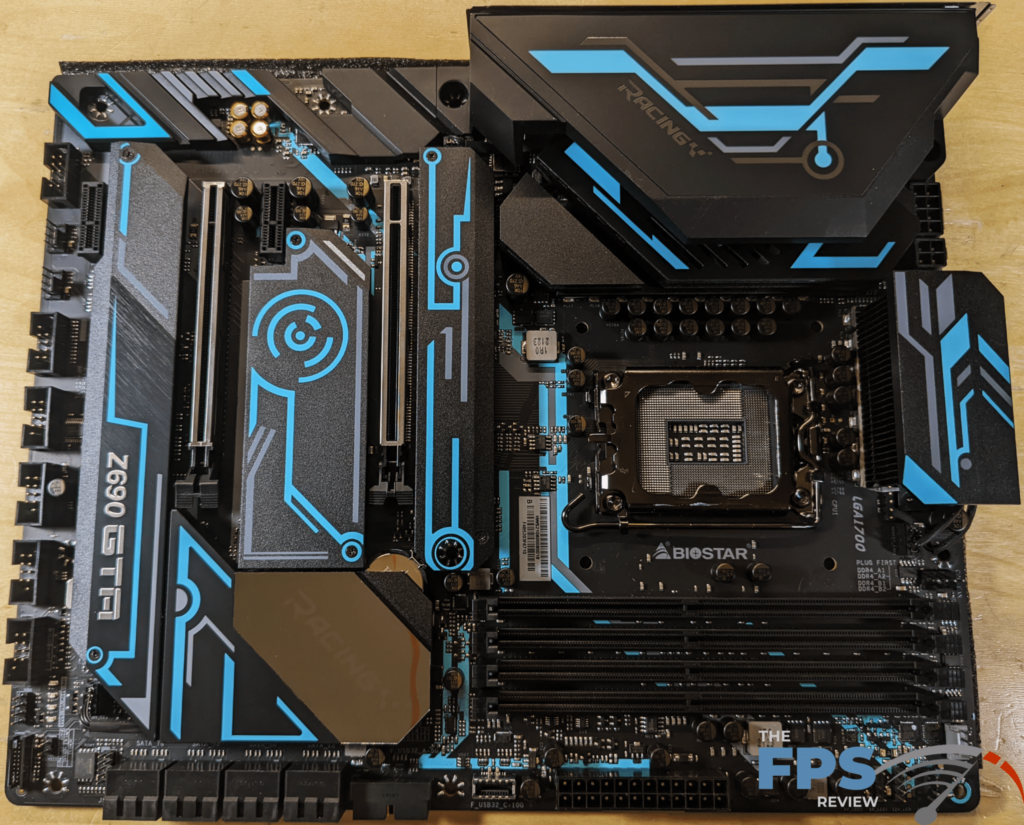
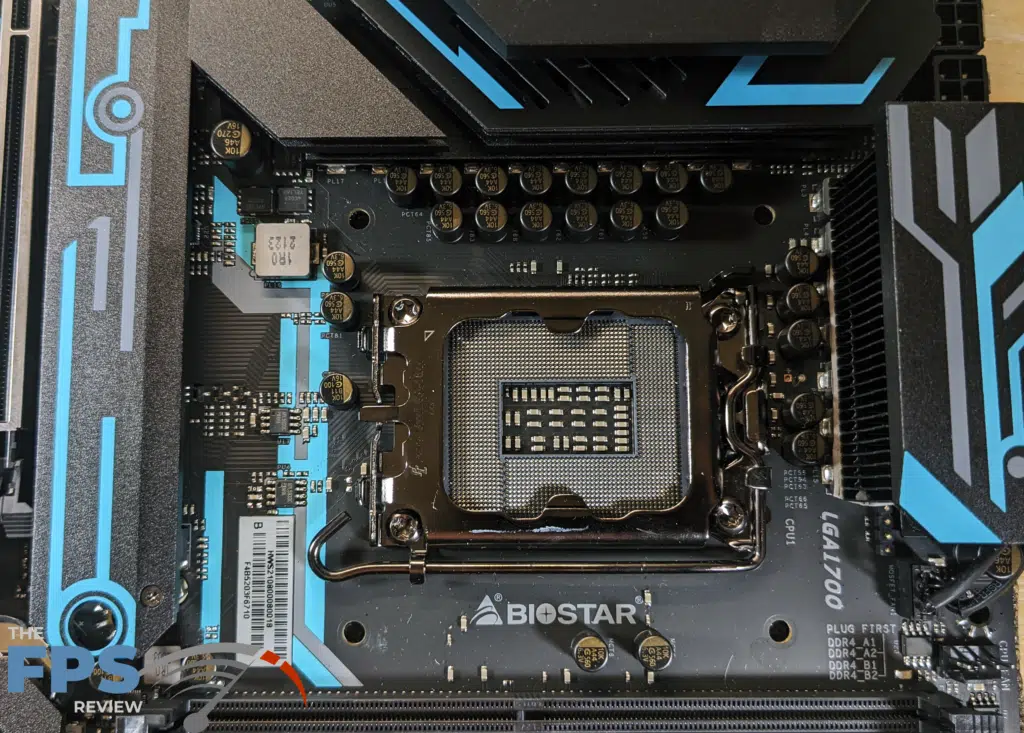
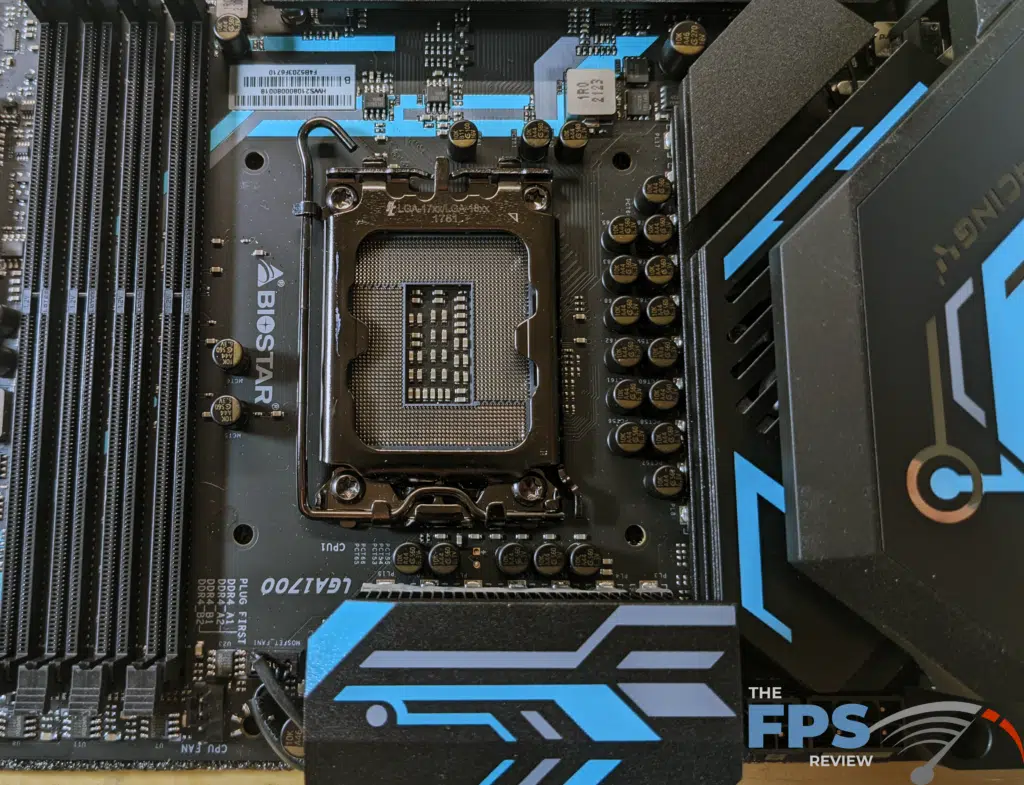

The layout of the PCB is good with no major issues or problems. About the worst offense is the location of the CMOS battery. However, while it’s not conveniently located it is visible with all of the M.2 heat sinks in place. That’s nice as you know what you are getting into if you’ve only ever seen a picture of it before deciding on this specific motherboard.
As you can see above, there is active cooling for the MOSFETs. While fans like these can be annoying, I never really heard them in my testing. I’m not massively sensitive to noise as long as it’s consistent. If the changes are very rapid in one direction or another, I get annoyed quickly and the active cooling never did that. Most of the time, I forgot it was even a feature of the board. The motherboard also has both an eight-pin and a four-pin CPU power connector. These are BIOSTAR’s “Tough Power Connectors” which have thicker voltage pins to handle higher loads for longer periods of time.
As you can also see in the images, the VRM heat sinks are fairly stout. However, they aren’t especially tall. That is to say, they don’t have the same clearance issues that some recent ASUS motherboards have with some cooling solutions. Unfortunately, the usual clearance issues are present with taller DIMMs and some air coolers. This is due to the distance between the CPU socket and the DIMM slots. This problem isn’t unique to BIOSTAR or even Intel-based systems as it’s more of a technical limitation of having a memory controller integrated into the CPU.
Expansion

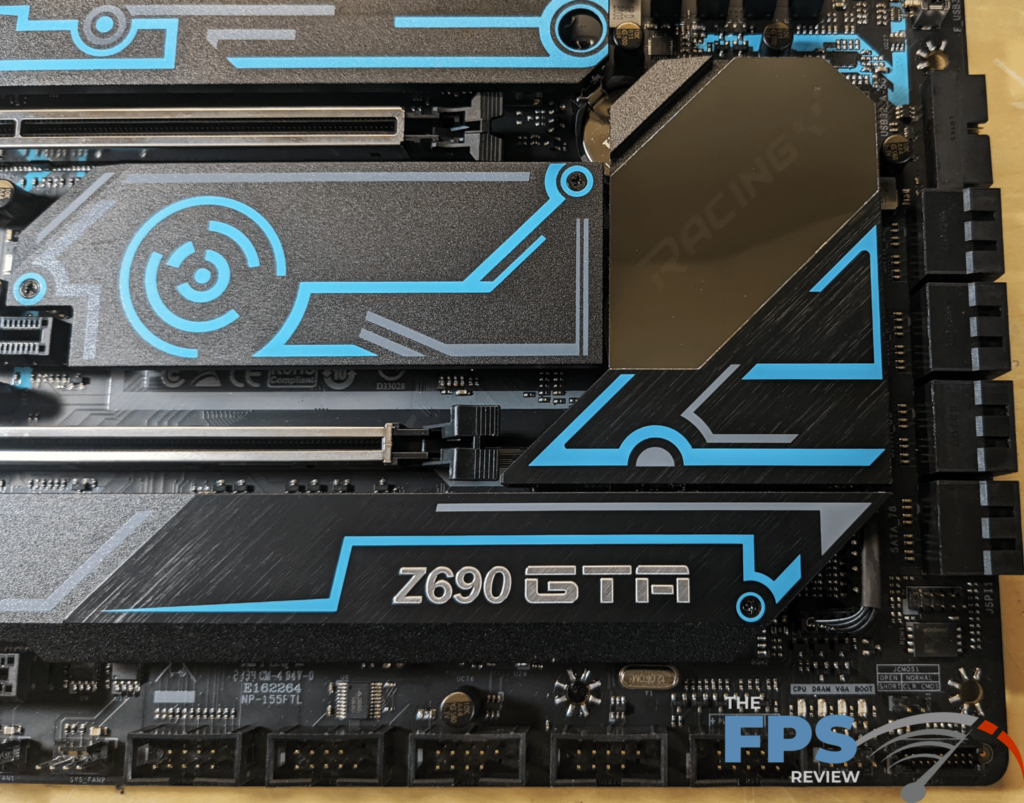
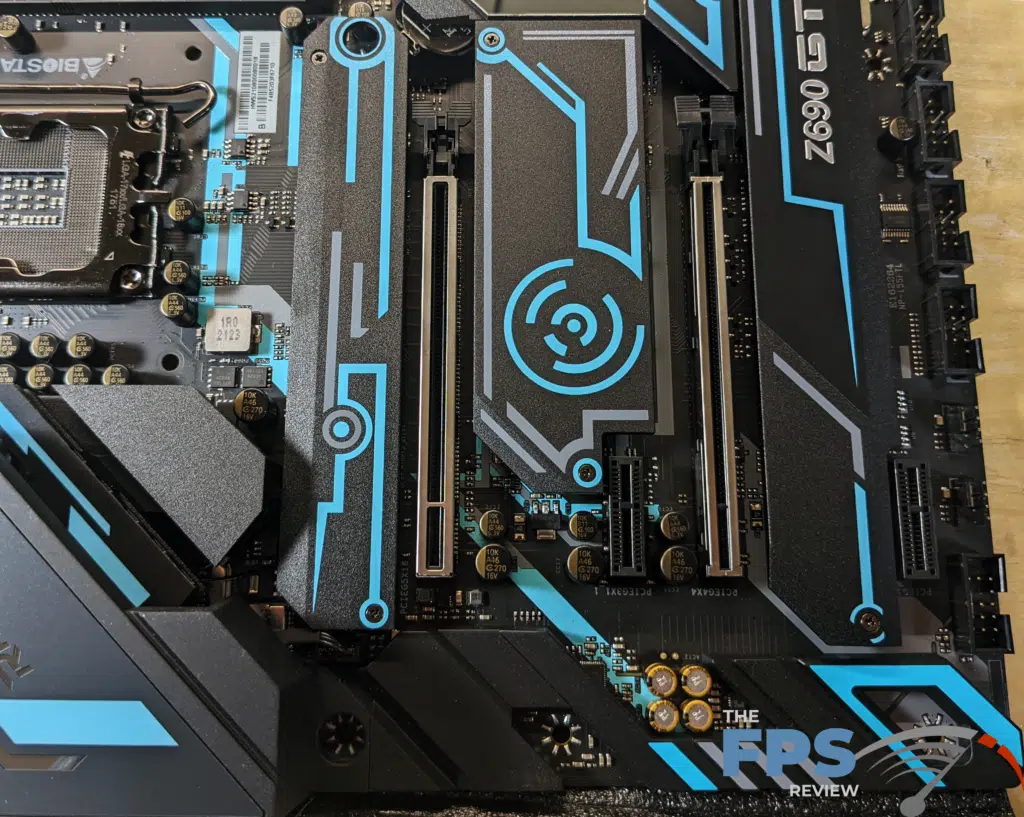

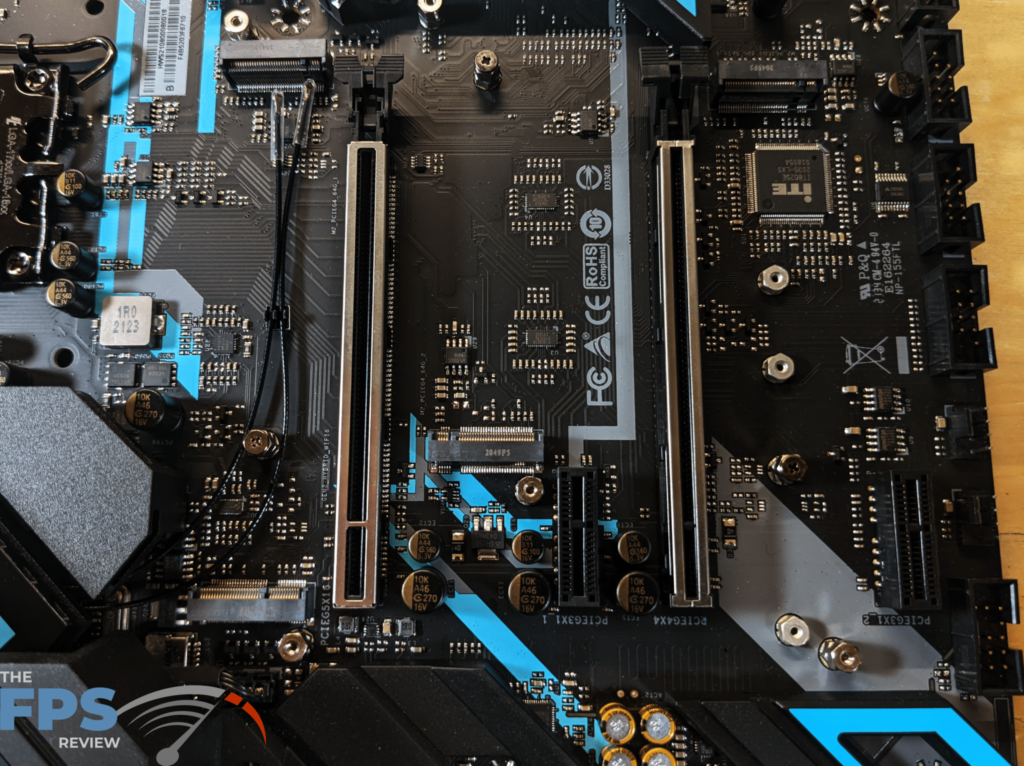
When it comes to expansion slots, the BIOSTAR Racing Z690 GTA is well thought out and offers a solid amount of expansion capability. There are two PCI-Express x16 slots. The primary x16 slot is a Gen 5.0 compliant slot with 16 PCI-Express lanes while the second is a Gen 4.0 PCIe x4 slot in the x16 form factor. There are also 2x PCIe 3.0 x1 slots.
BIOSTAR utilizes its “Iron Slot Protection” for both PCI-Express x16 form factor slots. This is steel reinforcement to prevent bending of the PCB and reduce stress on the slots from the use of heavier graphics cards. Modern GPUs can weigh a lot and seem to get heavier nearly every generation making this a more prudent feature than it has been in the past.
You will also find 3x M.2 slots on the BIOSTAR Racing Z690 GTA and one additional M.2 slot which is reserved for Wifi 6E cards. This one also has two leads for the wireless antenna ports located on the I/O shield. For NVMe devices, Two of the slots support devices up to 80mm in length while one supports 110mm devices. One of the slots also supports SATA-based M.2 devices.
Interestingly, I do not see PCIe Gen 5.0 support on any of the M.2 slots. For whatever reason, BIOSTAR decided to forgo that possibility. Today, that’s not a huge deal as I have yet to see any PCIe 5.0 NVMe devices for sale. However, if you want to try and future-proof your rig as much as possible, this is potentially a downside. That being said, that requires lanes from the CPU in order to implement. So I can see why Biostar didn’t go that route. However, options are never a bad thing.
Additionally, you do get eight SATA III 6Gb/s ports with the BIOSTAR Racing Z690 GTA. However, only four of them support RAID 0, 1, 5, &10, and Intel’s Rapid storage technology. The other ports are connected to an ASMedia 1064 controller. It has been a very long time since we’ve seen a third-party controller integrated into a motherboard, so it was surprising.
Audio Hardware
For audio, the BIOSTAR Racing Z690 GTA utilizes a Realtek ALC1220 HD audio CODEC. This is a budget CODEC for this generation, though it was once the higher end of the Realtek options. It’s since been supplanted by the Realtek ALC4082 on higher-end motherboards. That being said, implementation with a CODEC is more important than the CODEC itself. You can have the best custom audio CODEC available, but if the implementation isn’t sound it won’t really matter.
As one would expect on a modern motherboard, BIOSTAR uses a ground isolation circuit design, which isolates the power for the audio from the rest of the motherboard electrical system to reduce crosstalk. BIOSTAR refers to this as its “Hi-Fi” Audio. Additionally, the Z690 GTA has “Hi-Fi Ground” which is a noise-blocking multilayer PCB design to isolate analog signals from digital sources. The layout is designed to be optimal to reduce noise. Additionally, the motherboard features a “Hi-Fi Cap”, or dedicated low noise, low distortion audio capacitors.
There is also BIOSTAR’s “Hi-Fi AMP”, which is a built-in amplifier for driving headphones from the front panel audio. BIOSTAR claims it can drive 100dB+ loads with low distortion.
I/O Panel

The I/O panel is packed with connectivity options. On the back panel you’ll find 2x WIFI Antenna Ports, 1x PS/2 Keyboard/ Mouse Port, 1x HDMI Port (HDMI2.0), 1x DP Port, 1x DVI-D Port, 1x USB 3.2 (Gen2) Type-C Port, 5x USB 3.2 (Gen2) Ports, 2x USB 2.0 ports, 1x RJ-45 LAN port and 3x gold plated mini-stereo audio jacks.
I’m not a fan of legacy ports such as the DVI-D-only connector on the back. The primary reason this is here is likely for emerging markets overseas where BIOSTAR has a much bigger footprint. In North America, this is something usually only seen on bargain-basement motherboard models. Granted, the BIOSTAR Racing Z690 GTA straddles the budget and mid-range segments so this connector isn’t entirely surprising even if it is almost totally pointless in 2022.
Like a lot of motherboards these days, the I/O shield on the BIOSTAR Racing Z690 GTA is built into the motherboard. BIOSTAR’s Armor Gear as the company calls it is a plastic shield that protects the I/O panel and offers some RGB lighting.
